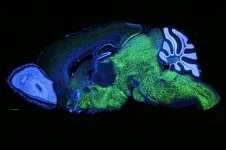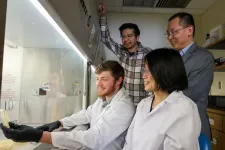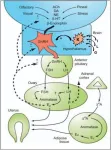(Press-News.org) The origins of human language remain mysterious. Are we the only animals truly capable of complex speech? Are Homo sapiens the only hominids who could give detailed directions to a far-off freshwater source or describe the nuanced purples and reds of a dramatic sunset?
Close relatives of ours such as the Neanderthals likely had anatomical features in the throat and ears that could have enabled the speaking and hearing of spoken language, and they share with us a variant of a gene linked to the ability to speak. And yet it is only in modern humans that we find expanded brain regions that are critical for language production and comprehension.
Now researchers from The Rockefeller University have unearthed intriguing genetic evidence: a protein variant found only in humans that may have helped shape the emergence of spoken language.
In a study published in Nature Communications, researchers in the lab of Rockefeller researcher Robert B. Darnell discovered that when they put this exclusively human variant of NOVA1—an RNA-binding protein in the brain known to be crucial to neural development—into mice, it altered their vocalizations as they called to each other.
The study also confirmed that the variant is not found in either Neanderthals or Denisovans, archaic humans that our ancestors interbred with, as is evidenced by their genetic traces that remain in many human genomes today.
“This gene is part of a sweeping evolutionary change in early modern humans and hints at potential ancient origins of spoken language,” says Darnell, head of the Laboratory of Molecular Neuro-Oncology. “NOVA1 may be a bona fide human ‘language gene,’ though certainly it’s only one of many human-specific genetic changes.”
Three decades in the making
Anatomical adaptations of the vocal tract and intricate neural networks enable our language capabilities. But the genetics behind them isn’t well understood.
One theorized genetic language driver is FOXP2, which codes for a transcription factor involved in early brain development. People with mutations in this gene exhibit severe speech defects, including the inability to coordinate lip and mouth movements with sound. Humans have two amino acid substitutions in FOXP2 that aren’t found in other primates or mammals—but Neanderthals had them too, suggesting that the variant arose in an ancestor of both human lineages. But some findings on FOXP2 have been disputed, and its role in human language development remains unclear.
Now NOVA1 has arisen as a candidate. The gene produces a neuron-specific RNA binding protein key to brain development and neuromuscular control that was first cloned and characterized by Darnell in 1993. It’s found in virtually identical form across a wide swath of the biosphere, from mammals to birds—but not in humans. Instead, we have our own unique form characterized by a single change of an amino acid, from isoleucine to valine, at position 197 (I197V) in the protein chain.
I197V isn’t the only amino acid substitution that distinguishes modern humans from other organisms, points out first author Yoko Tajima, a postdoctoral associate in Darnell’s lab. Several of them may be integral to brain development. “Such changes may have played important roles in the acquisition of characteristics that have contributed to the emergence, expansion, and survival of Homo sapiens,” she says.
A specialist in how RNA binding proteins modulate gene expression, Darnell has been researching NOVA1 since the early 1990s, when he and his colleagues first identified it as the trigger of a neurologic autoimmune disorder called POMA that can cause extreme motor dysfunction. Recently they have begun to identify cases in which NOVA1 genetic variants are associated with developmental language and motor difficulties.
“Understanding NOVA1 has been a career-long effort for me,” he says.
The current study, led by Tajima, used CRISPR gene editing to replace the common NOVA1 protein found in mice with the human variant I197V. They then used advanced techniques such as cross-linking immunoprecipitation (CLIP) analysis, a method developed by Darnell, to identify the RNA binding sites of NOVA1 in the mouse midbrain.
The big reveal
The first notable discovery was that the human variant had no impact on RNA binding related to neural development or motor control. It operated exactly as the one it had replaced.
So what was it doing? The second significant finding gave them a hint: binding sites that were substantially affected by the human variant were located at genes that coded for RNAs related to vocalization.
“Moreover, many of these vocalization-related genes were also found to be binding targets of NOVA1, further suggesting the involvement of NOVA1 in vocalization,” says Tajima.
“We thought, wow. We did not expect that,” Darnell says. “It was one of those really surprising moments in science.”
Darnell’s lab then joined forces with Rockefeller’s Laboratory of Neurogenetics of Language, headed by Erich D. Jarvis, who studies the molecular and genetic mechanisms underlying vocal learning.
Altered communications
Over the next few years, the collaborators investigated the impact on vocalizations among mice of various ages in different contexts. They found altered vocal patterns among both pups of both sexes and adult males.
“All baby mice make ultrasonic squeaks to their moms, and language researchers categorize the varying squeaks as four ‘letters’—S, D, U, and M,” Darnell notes. “We found that when we ‘transliterated’ the squeaks made by mice with the human-specific I197V variant, they were different from those of the wild-type mice. Some of the ‘letters’ had changed.”
They found similar patterns when they studied the hopeful mating calls of male adult mice exposed to female adult mice in estrus. “They ‘talked’ differently to the female mice,” he says. “One can imagine how such changes in vocalization could have a profound impact on evolution.”
The human element
The potential influence of I197V on human evolution became their next focus. To confirm that it wasn’t found in our nearest human relatives—the Neanderthals, who largely lived in Europe, and the Denisovans, named after the central Asian cave where they were discovered—the researchers compared eight human genomes with three high-coverage Neanderthal genomes and one high-coverage Denisovan genome.
As expected, our archaic relatives—from whom we are thought to have split about 250,000-300,000 years ago—had the same NOVA1 protein as all non-human animals.
They then combed through 650,058 modern human genomes in the dbSNP database, a catalog of short sequence variations drawn from people around the world. If an alternative to I197V existed, it would be found here.
Of those 650,058 people, all but six had the human variant. Those six had the archaic variant; because the samples are de-identified, details about them are unknown.
“Our data show that an ancestral population of modern humans in Africa evolved the human variant I197V, which then became dominant, perhaps because it conferred advantages related to vocal communication,” he suggests. “This population then left Africa and spread across the world.”
Disease and disorders
In the future, Darnell’s lab will investigate how NOVA1 regulates language function with an eye on language or developmental disorders.
“We believe that understanding these issues will provide important insights into how the brain operates during vocal communications—and how its misregulation leads to certain disorders,” says Tajima.
Its neural pathways may come into play, for example, when various disorders renders someone unable to speak. Perhaps it influences the development of nonverbal autism; NOVA1 is one of the many genes linked to autism spectrum disorder. And in 2023, the lab reported on a patient with a NOVA1 haploinsufficiency whose neurological symptoms included a speech delay.
Adds Darnell: “Our discovery could have clinical relevance in many ways, ranging from developmental disorders to neurodegenerative disease.”
END
A single protein may have helped shape the emergence of spoken language
2025-02-18
ELSE PRESS RELEASES FROM THIS DATE:
Scientists decode diet from stool DNA – no questions asked
2025-02-18
SEATTLE – Scientists have developed a breakthrough method to track diet using stool metagenomic data.
Developed by researchers at the Institute for Systems Biology (ISB), the new method, called MEDI (Metagenomic Estimation of Dietary Intake), detects food-derived DNA in stool samples to estimate dietary intake. MEDI leverages stool metagenomics, which refers to sequencing all the DNA present in fecal samples (including microbial, human, and food-derived DNA). This non-invasive, data-driven approach offers an objective alternative to traditional food diaries and questionnaires, ...
Biologists transform gut bacteria into tiny protein pharmacies
2025-02-18
Hundreds of different species of microbes live, laugh, and love in your gut. In the future, one of these might serve a new function: microscopic in-house pharmacist.
A new study published Feb. 18 in Nature Biotechnology shows how gut bacteria can be directed to produce and release proteins within the lower gastrointestinal tract — eliminating a major roadblock to delivering drugs to that part of the body.
Oral medication is the most common and practical means of drug administration, but the stomach doesn’t let much pass through unscathed. This is good when it comes to things like foodborne ...
Study sheds light on the genetics of stopping smoking
2025-02-18
The effectiveness of a common drug to quit smoking could be down to people’s genes, according to a study from the University of Leicester (United Kingdom).
Varenicline is widely recognised as the most effective medication for helping people stop smoking, but unfortunately it does not work for everyone.
Researchers from Leicester have uncovered important insights into how people’s DNA affects their response to the drug, which will soon be available to smokers through the UK’s National Health Service (NHS).
Varenicline ...
Landmark review maps complex interactions between sex hormones and neurological health
2025-02-18
MONTREAL, Québec, Canada, 18 February 2025 - A comprehensive review published today in Brain Medicine by leading neuroendocrinologist Professor Hyman M. Schipper from McGill University’s Department of Neurology and Neurosurgery maps out the extensive influence of reproductive hormones on neurological health and disease. This landmark review, appearing in a special Festschrift issue honoring Dr. Seymour Reichlin’s centennial, systematically examines how sex hormones affect a broad ...
Restoring African grassland habitats makes life more peaceful for humans and wildlife, scientists find
2025-02-18
Across Kenya, grasslands underpin people’s lives — as well as those of animals like elephants, giraffes, and hyenas. But the climate crisis is drying out these habitats, forcing people and animals to compete for resources, and increasing both community tensions and conflict between humans and wildlife. Researchers monitoring both grassland restoration and conflicts have now found that restoration can help reduce human-wildlife conflict and improve community relations: the more local grassland is restored, the less conflict there is.
“Grassland restoration is playing a role in reducing human-wildlife conflicts, social conflicts and the overall feeling of insecurity ...
Ventilation fans can significantly lower the risk of inhaling bacteria particles after toilet flushing
2025-02-18
Bioaerosol emissions during toilet flushing are an often-overlooked source of potential health risks in shared public facilities. A new study published in Risk Analysis found that bioaerosol concentrations of two bacteria -- Escherichia coli (E. coli) and Staphylococcus aureus (S. aureus) -- exceeded acceptable levels established by the Centers for Disease Control (CDC) after toilet flushing. Inhaling these biological particles can produce symptoms like abdominal cramps, nausea, diarrhea, and vomiting.
The research was conducted in two restrooms located in an office building in China. One contained a squat toilet and the other a bidet toilet. Scientists measured the emissions ...
Legionnaires’ disease from a lake swim
2025-02-18
Swimming in some lakes with still water can lead to infection with Legionella, bacteria that can cause pneumonia, and people who engage in open water swimming should be aware of this risk, say the authors of a practice article published in CMAJ (Canadian Medical Association Journal) https://www.cmaj.ca/lookup/doi/10.1503/cmaj.241086.
“Legionella infection represents a public health hazard owing to its ability to spread through exposure to natural water bodies and human-made water reservoirs,” writes Dr. Ashley Bryson, an internal medicine resident at the University of Manitoba, with coauthors.
Legionella infection is an atypical cause of community-acquired ...
New remotely-delivered support programme could deliver excellent care while saving the NHS and social care an average of £9000 a year for each person with dementia
2025-02-18
UNDER STRICT EMBARGO UNTIL UNDER STRICT EMBARGO UNTIL MONDAY 17 FEBRUARY 2025 AT 23.30 (UK TIME).
Peer reviewed | Randomised Controlled Trial | People
The NIDUS-Family package of care uses goal setting to help people with dementia live well at home for longer. New research from Queen Mary University of London in collaboration with UCL shows that, in addition to these known benefits, NIDUS-Family also reduces the costs associated with providing support to people with dementia.
Approximately ...
Global action needed to solve the medical oxygen crisis
2025-02-18
Targets for universal access, national roadmaps and more affordable and accessible care are vital to help fill the medical oxygen gap affecting more than half of the world’s population, according to a new global report.
The Lancet Global Health Commission report details for the first time how future investment in strengthening medical oxygen systems could have a huge impact by saving millions of lives and improving pandemic preparedness.
Almost 400 million children and adults require medical oxygen every year. More than five billion people, 60 per cent of the world’s population, don’t have access to safe and ...
Study findings raise questions about the inclusion of sepsis bundle in the CMS value program
2025-02-17
Embargoed for release until 5:00 p.m. ET on Monday 17 February 2025
@Annalsofim
Below please find summaries of new articles that will be published in the next issue of Annals of Internal Medicine. The summaries are not intended to substitute for the full articles as a source of information. This information is under strict embargo and by taking it into possession, media representatives are committing to the terms of the embargo not only on their own behalf, but also on behalf of the organization they represent.
----------------------------
1. ...


